Allen Franklin Gardner

Allen Franklin Gardner served in the United States Army with the 252nd Combat Engineers of the 82nd Airborne Division at the end of World War II from 1945 through 1947. The War ended as the division crossed the Atlantic Ocean en route to Germany. While in Germany, Mr. Gardner reported seeing factories designed underground to build airplanes and by the time a plane reached ground level it could be airborne. As part of the occupation forces, Mr. Gardner's unit witnessed the Russian occupation of Berlin, Germany. Upon returning after the war, Mr. Gardner purchased his first home under the G.I. Bill, where he and his wife, Frances, raised a family of three sons. Mr. Gardner was member of the Church of Jesus Christ of Latter Day Saints.
Update: Mr. Gardner provided an oral history of his military experience prior to his death in 2006. Mr. Gardner's account began our oral history collection.
>Back to Top<
Bonus March of 1912
Reprinted in part from wikipedia.com
The Bonus Army or Bonus March or Bonus Expeditionary Force was an assemblage of about 20,000 World War I veterans, their families, and other affiliated groups who demonstrated in Washington, D.C. during the spring and summer of 1932 seeking an immediate payment of a "bonus" granted by the Adjusted Service Certificate Law of 1924 for apyment in 1945. They were led by Walter W. Waters, a former Army sergeant, and encouraged by an appearance from retired Marine Corps Major General Smedley Butler, one of the most popular military figures of the time.
The Bonus Army massed at the United States Capitol on June 17 as the U.S. Senate voted on the Patman Bonus Bill, which would have moved forward the date when World War I veterans received a cash bonus. Most of the Bonus Army camped in a Hooverville on the Anacostia Flats, then a swampy, muddy area across the Anacostia River from the federal core of Washington. The protesters had hoped that they could convince Congress to make payments that had been granted to veterans immediately, which would have provided relief for the marchers who were unemployed due to the Depression. The bill had passed the House of Representatives on June 15 but was blocked in the Senate.
After the defeat of the bill, Congress appropriated funds to pay for the marchers' return home, which some marchers accepted. On July 28, Washington police attempted to remove some remaining Bonus Army protesters from a federal construction site. After police fatally shot two veterans, the protesters assaulted the police with blunt weapons, wounding several of them. After the police retreated, the District of Columbia commissioners informed President Herbert Hoover that they could no longer maintain the peace, whereupon Hoover ordered federal troops to remove the marchers from the general area.
The marchers were cleared and their camps were destroyed by the 12th Infantry Regiment from Fort Howard, Maryland, and the 3rd Cavalry Regiment under the command of Maj. George S. Patton from Fort Myer, Virginia, under the overall command for General Douglas MacArthur. The Posse Comitatus Act, prohibiting the U.S. military from being used for general law enforcement purposes in most instances, did not apply to Washington, D.C. because it is one of several pieces of federal property under the direct governance of the U.S. Congress (United States Constitution, Article I, Section 8). Dwight D. Eisenhower, as a member of MacArthur's staff, had strong reservations about the operation. Troops carried rifles with unsheathed bayonets and tear gas were sent into the Bonus Army's camps. President Hoover did not want the army to march across the Anacostia River into the protesters' largest encampment, but Douglas MacArthur felt this was a communist attempt to overthrow the government. Hundreds of veterans were injured; several were killed, including William Hushka and Eric Carlson. A wife of a veteran miscarried and other casualties were inflicted. The visual image of U.S. armed soldiers confronting poor veterans of the recent Great War set the stage for Veteran relief and eventually the Veterans Administration.
By the end of the route:
- Two veterans were shot and killed
- An 11 week old baby was in critical condition resulting from shock from gas exposure.
- Two infants died from gas asphyxiation
- An 11 year old boy was partially blinded by tear gas
- One bystander was shot in the shoulder
- One veteran's ear was severed by a Cavalry saber
- One veteran was stabbed in the hip with a bayonet
- At least twelve police were injured by the veterans
- Over 1000 men, women, and children were exposed to the tear gas, including police, reporters, residents of Washington, D.C., and ambulance drivers.
The army burned down the Bonus Army's tents and shacks, although some reports claim that to spite the government, which had provided much of the shelter in the camp, some veterans torched their own camp dwellings before the troops could set upon the camp. Reports of U.S. soldiers marching against their peers did not help Hoover's re-election efforts; neither did his open opposition to the Bonus Bill due to financial concerns. After the inauguration of Franklin D. Roosevelt in 1933, some of the Bonus Army regrouped in Washington to restate its claims to the new President. Roosevelt did not want to pay the bonus early, either, but handled the veterans with more skill when they marched on Washington again the next year. He sent his wife Eleanor to chat with the vets and pour coffee for them, and she persuaded many of them to sign up for jobs making a roadway to the Florida Keys, which was to become the Overseas Highway, the southermost portion of U.S. Route 1. On September 2, the disastrous Labor Day Hurricane of 1935 swept many of them and their flimsy barracks away. After seeing more newsreels of veterans giving their lives for a government that had taken them for granted, public sentiment built up so much that Congress could no longer afford to ignore it in an election year (1936). Roosevelt's veto was overridden, making the bonus a reality.
It can be argued, however, that the Bonus Army's greatest accomplishment was actually the piece of legislation known as the G.I. Bill of Rights. Passed in 1944, it immensely helped veterans from the Second World War to secure needed assistance from the federal government to help them fit back into civilian life, something of which the World War I veterans of the Bonus Army had received very little.
>Back to Top<
G.I. Bill
Reprinted in part from wikipedia.com.
The Servicemen's Readjustment Act of 1944 (better known as the G.I. Bill) provided for college or vocational education for returning World War II veterans (commonly referred to as GIs or G.I.s) as well as one year of unemployment compensation. It also provided loans for returning veterans to buy homes and start businesses.
The G.I. Bill is considered to be the last piece of New Deal legislation. However, the bill which President Franklin D. Roosevelt initially proposed was not as far reaching.
The G.I. Bill was created to prevent a repeat of the Bonus March of 1932 and a relapse into the Great Depression after World War II ended. The American Legion (a veterans group) is essentially responsible for many of the bill's provisions. The Legion managed to have the bill apply to all who served in the armed services, including African-Americans and women. The fact that the G.I. Bill paid for a G.I.'s entire education had encouraged many universities across the country to expand enrollment. For example, the University of Michigan had fewer than 10,000 students prior to the war. In 1948, their enrollment was well over 30,000. Syracuse University also embraced the spirit of the Bill and saw their enrollment skyrocket from approximately 6,000 before the war to 19,000 students in 1947.
Another provision was known as the 52-20 clause. This enabled all former servicement to receive $20 once a week for 52 weeks a year while they were looking for work. Less than 20 percent of the money set aside for the 52-20 Club (as it was known) was distributed. Most returning servicemen quickly found jobs or pursued higher education.
An important provision of the G.I. Bill was low interest, zero down payment home loans for servicemen. This enabled millions of American families to move out of urban apartments and into suburban homes. The G.I. Bill of Rights has since been modified but still remains on the books.
>Back to Top<
Arnim L. Harris
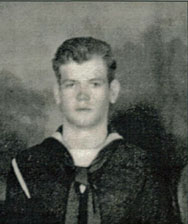
Arnim Harris Jr. joined the United States Navy in September of 1943. He was stationed in Jacksonville, Florida, trained as an airplane mechanic and assigned to the USS Tangier (AV-8) at the end of World War II. The crew of the USS Tangier was likely experienced in the ways of war by this time, having had the distinction of surviving the Japanese attack at Pearl Harbor.
His work with airplanes, no doubt, sparked an interest and while in the Navy, Mr. Harris learned to fly, taking his first lesson on October 1, 1944. This began a lifelong association with aviation.
After his discharge from the Navy, Mr. Harris work for Cavalier Aviation as a crop duster as well as for Aero Industries as a flight instructor and charter pilot.
An interesting story is that, he would fly over the home of his best girl, Betty Brock, and dropnotes making arrangements for dates. Apparently that won Betty’s heart because they later married and raised a family of five children. In 1952, Arnim was the pilot for the Commanding General of the Corps of Engineers based in Richmond and in October 1953, he began employment with Eastern Airlines. During his many years of association with Eastern Airlines he was promoted to the position of Captain.
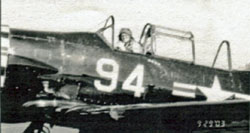
While employed with the airline, Captain Harris, in addition to probably being a wide variety of aircraft was also the Chief Accident Investigator for the Airline Pilots Association. He also served as the Air Safety Committee Chairman. In addition to being awarded the Airline Pilots Association International “Pilot of the Year” in 1979, he was appointed Chairman of the Cockpit Design Committee for the Boeing 757 in the 1980’s. Captain Harris retired from Eastern Airlines in 1985 and was #1 ranked Captain with over 35,000 flying hours. To the left is Captain Harris flying in celebration of this 80th birthday at Hanover Airport.
Captain Arnim L. Harris Jr. was recently inducted into the Virginia Aeronautical Historical Society Hall of Fame.
Post note: Captain Harris is not the first of his family to hold the title of Captain. He has traced his ancestry back to Captain Thomas Harris, early settler of Henrico County from the time of Sir Thomas Dale who held the first recorded patent for property known as Longfield, later to become Curles Neck.
>Back to Top<
USS Tangier, September 2007
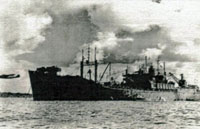
USS Tangier (AV-8): The USS Tangier, first of a class of three 11,760-ton seaplane tenders, was launched at Oakland, California in 1939 as the merchant ship Sea Arrow. Taken over by the Navy 1940, she remained at her builders’ for conversion work and went into full commission in August 1941.
Note a PBY patrol seaplane flying past below the bow and a seaplane on the aft deck in the far right of the photo.
Tangier went to Pearl Harbor in November and was employed supporting the expanded force of patrol seaplanes based there during a time of increasing tension with Japan. She was present during the December 7, 1941 air raid on Pearl Harbor and was slightly damaged when a Japanese bomb exploded nearby.
When the Japanese attacked Pearl Harbor on December 7, 1941, USS Tangier was moored astern of the USS Utah (AG-16). That ship was torpedoed and sunk, and the nearby seaplane tender Curtiss (AV-4) was hit by a bomb and a crashing enemy plane. However, Tangier’s only damage, from a bomb near-miss, was superficial. Her guns actively engaged Japanese planes, claiming to have shot down three, and also fired on an enemy midget submarine subsequently sunk by the destroyer Monaghan (DD-354). She also took part in rescue efforts during and after the attack.
About a week later, Tangier was sent toward Wake Island with supplies for its Marine garrison, but was recalled when Wake was captured by Japanese forces on December 23. In February 1942, the tender steamed to the South Pacific, where she stayed until June, maintaining seaplane patrols out of Noumea, New Caledonia. Her planes played a supporting role in the May 1942 Battle of the Coral Sea.
Following a West Coast overhaul, Tangier again was based in the South Pacific in February-August 1943, then served on transport duty between the war zone and the United States. From March 1944 until June 1945, the ship's base moved steadily forward from Australia to the Philippines as her seaplanes assisted the Seventh Fleet and General MacArthur's forces during their advance across New Guinea and northward.
Tangier was receiving the attentions of a statewide shipyard when the Pacific War ended in August 1945, but was sent back to the Far East to support occupation efforts from October 1945 into March 1946. She then made the long trip back to the US, passing through the Panama Canal and arriving at Norfolk, Virginia in late April. The next month, she began deactivation at Philadelphia, Pennsylvania. Tangier decommissioned there in February 1947 and remained in the Atlantic Reserve Fleet until 1961. In November of that year she was sold for scrapping.
(Reprinted from Naval Historical Center website.)
>Back to Top<
The Virginia Aeronautical Historical Society
The idea for the society was fostered by Morten W. Lester, a well-known Virginia aviation enthusiast from Martinsville, who saw the need to preserve and display rapidly disappearing aviation artifacts in Virginia. Lester soon found other Virginians who shared his vision to establish a Virginia Aeronautical Historical Society. On November 30, 1977, that vision became a reality when the Virginia Aeronautical Historical Society was launched by a group of interested Virginia citizens. The Society is permanently headquartered in the Virginia Aviation Museum at the Richmond International Airport.
The original purpose of the organization was to “study, research, interpret, preserve, and disseminate Virginia's aviation and aeronautical heritage, and to preserve, acquire, and display those items pertaining to Virginia’s aviation and aeronautical heritage”.
The objectives of the Virginia Aeronautical Historical Society are to:
1. Prepare, collect, and preserve documents, aircraft, aerospace vehicles, and other items which relate to the history of aviation and aerospace in Virginia, from its beginning to the present
2. Educate the general public with emphasis on young people, on the contribution which Virginia has made and is making to the development in aviation and aerospace;
3. Provide aid and support to the Virginia Aviation Museum and those Virginia institutions; and
4. Promote aviation in Virginia.
To support the mission, the Virginia Aeronautical Historical Society operates and directs a number of programs.
- The Virginia Hall of Fame: one of the most successful projects sponsored by the Virginia Aeronautical Historical Society-the Hall of Fame-was created to honor Virginians who have made significant contributions to the development of aviation. New inductees are honored at an annual Hall of The Dinner hosted in November of each year.
- Historical Marker Program: Virginia is the site of many aviation firsts and one of the projects of the VAHS is to commemorate those sites with roadside historical markers. Working in conjunction with the Virginia Department of Transportation, a number have already been erected around the state commemorating such events as the first ship-to-shore flight, the first passenger flight, the first later-than-air flight in North America, and the unfortunate notice of the first aviation passenger fatality. Many other firsts are also on record in efforts are continuing to expand the number of these markers around the state.
- Oral History Project: so as not to be lost forever, the oral history program is the designed to interview and record the stories of Virginia's aviation pioneers and others instrumental in the state’s aeronautical advancement.
- Airport History Project: Virginia is the location of one of the earliest and many of the most important airports in the nation.
To commemorate these significant airports the society has published a book entitled Virginia Airports-A Historical Survey of Airports and Aviation from the Earliest Days by Vera Roster Rollo, PhD and Norman L. Crabill. To purchase this very informative 252 page book or for questions relating to the Society call the office at (804)222-8690 or e-mail vahs@smv.org.
(Reprinted from the VAHS website)
>Back to Top<
Robert Hawkes, Sr. and Robert Hawkes, Jr. - Two Generations of Veterans
Robert E. Hawkes, Sr.
1920-1981
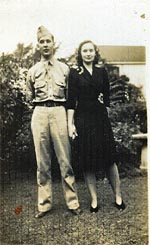
Robert E. Hawkes, Sr., was a veteran of World War II and served the rank of Corporal with the Engineer Corp., Third US Army under General George S. Patton. After having just married in July, Robert Hawkes, Sr., reported for duty at Fort Belvoir in September 1943. On June 10, 1944, 4 days after D-Day, and the new father of young Robert, Jr., Corporal Hawkes landed with his unit at Normandy and began an arduous trek across France, Belgium, Luxembourg, and Germany. The Battle of the Bulge blocked communication with home, and from December to February of 1944, his family had no word of his safety.
Interestingly, two of his friends from Glen Allen, Virginia, went into the Army at the same time as Robert, Sr., stayed together throughout the war, and came home together on the same ship. After the war, Mr. and Mrs. Hawkes (left) raised a family of three children in the Lakeside area. Wartime couple, Corporal Robert E. Hawkes, Sr., and wife Eunice Sheppard Hawkes and (below) two Christmas cards he sent home.
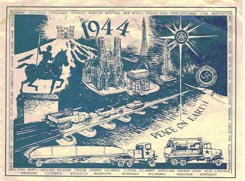
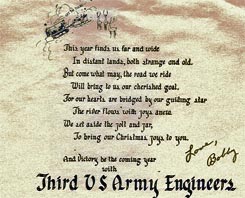
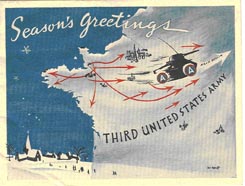
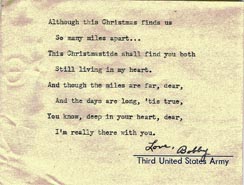
Robert E. Hawkes, Jr.
1943-2007
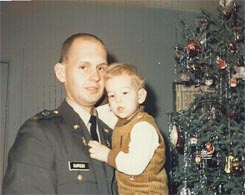
Colonel Hawkes began his military experience while attending the University of Richmond and participating in the ROTC program.
He graduated in 1965. He had to leave his wife, Marguerite and small son (left with his father), when he went on his first tour of duty with the US Army, on May 15, 1968.
He worked in military intelligence in Vietnam and Germany, and his family did not know too much at that time of his military activities because of the operations in which he was involved. It is known, however, that in Saigon, he did not wear his uniform but dressed in civilian clothes with it only a military-issued pistol in his possession for protection.
It is said that many civilians who knew him in Vietnam did not know he was with the military and that he possibly was a minister.
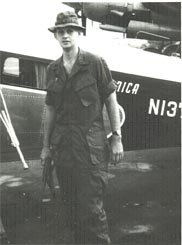 Robert E. Hawkes, Jr. in fatigues on his way to R&R.
The following is a note written to his mother while there:
Sunday
8 September 1968,
Saigon, Vietnam.
Dear Mother,
I hope you enjoy using your tablecloth. I think it is very lovely. The scenes embroidered on the cloth remind me of the farmers in Phu Tay Provence.
Today I finally got a chance to go to the PX and purchase these cards. The last two weeks have been busy. Today at the PX outlet at Tay Son Nhut it was as if everybody was there.
Mother, I hope you can understand why this card is delayed. I feel bad about it, but everything that I have ever learned has taught me that duty comes first, then personal life.
I wish you a Happy Birthday! I am as always,
Your loving son,
Bob
Colonel Hawkes received the Meritorious Service Medal, Defense Service Ribbon, and the Vietnam Service Medal with four stars. He returned from Vietnam May 6, 1969, and continued his career with the US army until discharged January 24, 2003.
He was buried with honors at Arlington National Cemetery on August 27, 2007.
>Back to Top<
Alonzo Hyatt Kelly (1889-1977) - A Henrico Veteran of the Great War
by Beverly A. Williams

I remember these stories as they were often told around my grandmother's dining room table during the many visits we paid them during my childhood. The stories are still told now by his youngest daughter, my mother, Ann Kelly Moore.
Lon, as his friends called him, was a young man when he was shipped off to fight in Europe during World War I in 1917. He left behind his young bride, who was expecting their first child. In the time he was there, he surely must have witnessed the many horrors of war, but we, his family never heard about those times. This kind man of Irish immigrant decent had a ready smile, an easy laugh, and endless humorous stories about his times growing up, and yes, even his times fighting the first major world war.
One of his stories that is best remembered recalled a time he was with his fellow troops being transported across France on railroad flatbed cars. The soldiers were out in the open, unprotected from the elements and enemy bullets. It wasn't long before German aircraft approached and began to strafe the railroad cars with their guns. Undoubtedly many men, with no cover to speak of, were shot on that fateful train ride. Lon thought that this too had been his fate when he felt a wetness begin to trickle down his body. Surely he had been shot. However, when he looked up, he discovered that a tank of water he had been sitting against had taken a hit and was slowly trickling harmless water over him. The relief he must have felt at cheating death yet another time during this terrible war may have been why he could relay this tale to his children and grandchildren with a smile on his face.
There was another time when his troops thought the Germans were getting too close. They didn't want the Germans to get their supply of coffee. So they dumped all they had into a big barrel and made a huge batch of very strong coffee. The troops then drank as much of it as they could stand. Dandy always said of that coffee and any strong coffee since that "it'd make you fight your granny." This he always said with a wide grin and a soft laugh.
Another time he recalled was when he and his fellow troops were resting - likely awaiting the next battle. As he dozed, the drizzling rain on his metal helmet made a ringing sound he dreamt was the bells of his church in Lee County calling its parishioners to pray. I wonder if that was a comfort to him as he slept, or if it saddened him to face the reality of war once again upon waking. Maybe it was both.
I remember finding Dandy's helmet once up in my grandmother's attic. It was large and very heavy. In the crown it bore a large dent, perhaps caused by flying shrapnel. I often wonder if that dent was evidence of my grandfather's life being spared when others weren't so lucky. I can only imagine what it must have been like for Dandy as he fought through Europe during that war. He never told us the sad or scary stories that I'm sure he must have experienced. He only told us the ones that made him laugh.
Post Script:
Alonzo Kelly and his wife Amanda Torbert Kelly settled in Richlands, Virginia after the war and raised a family of five children. Their daughter, Ann Kelly Moore is a long time resident of Henrico County. Granddaughter, Beverly A. William, also is a resident of Henrico County and is a speech pathologist for the County of Henrico school system.
>Back to Top<
Welford Lloyd Williams
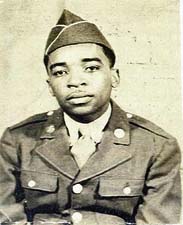
Welford Williams, after being inducted April 14, 1943, with active duty beginning on April 21st, served in the 3393 Quarter Master Truck Company of the U.S. Army during World War II. First arriving at Liverpool, England on May 18, 1944, his unit landed on Omaha Beach (Normandy) July 6, 1944. By wars end his outfit had been in many areas of France, Belgium and the Country of Luxembourg.
Mr. Williams wrote, “Who could ever forget the German Buzz-bombs that hit so close to areas we traveled and rested.” During his service he guarded prisoners and drove on the Red Ball Express (convoy) supplying troops. Mr. Williams describes the Red Ball Express as having a direct road to the troops in order to get supplies to the lines in a hurry when needed. One of his wartime experiences involved flipping one of the vehicles used to deliver supplies.
Upon discharge, Dec. 26, 1945, he had earned the American Theater Service Medal with 5 bronze stars; Victory and Good Conduct Medals. He was also awarded a Drivers Badge and Marksmanship on weapons: 03,M1, carbine, hand grenade, bazooka, and 30 caliber machine gun.
After the war Mr. Williams married Willie Mae Love and had a family of 8 children. He retired from the US Postal Service, and in later years worked as a guard at the Henrico County Government Center. Mr. Williams currently serves as Director of the Fairfield District for the Henrico County Historical Society.
>Back to Top<
The History of the Bronze Star Medal
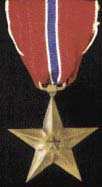
The Bronze Star Medal is a United States Armed Forces individual military decoration which may be awarded for bravery, acts of merit, or meritorious service. When awarded for bravery, it is the fourth-highest combat award of the U.S. Armed Forces and the 9th highest military award (including both combat and non combat awards) in the order of precedence of U.S. military decorations. (Note: When awarded for valor it is accompanied with an attached V. When awarded for meritorious service it does not have the valor component.)
The award that eventually became the Bronze Star Medal was conceived by Colonel Russel P. “Red” Reeder in 1943, who believed it would aid morale if there was a medal which could be awarded by captains of companies or batteries to deserving people serving under them. Reeder felt the medal should be a ground equivalent of the Air Medal, and proposed that the new award be called the “Ground Medal”.
The idea eventually rose through the military bureaucracy and gained supporters. General George C. Marshall, in a memorandum to President Franklin D. Roosevelt dated 3 February 1944, wrote, “The fact that the ground troops, Infantry in particular, lead miserable lives of extreme discomfort and are the ones who must close in personal combat with the enemy, makes the maintenance of their morale of great importance. The award of the Air Medal have had an adverse reaction on the ground troops, particularly the Infantry Riflemen who are now suffering the heaviest losses, air or ground, in the Army, and enduring the greatest hardships.”
The Air Medal had been adopted two years earlier to raise airmen's morale. President Roosevelt authorized the Bronze Star Medal by Executive Order 9419 dated 4 February 1944, retroactive to 7 December 1941. This authorization was announced in War Department Bulletin No. 3, dated 10 February 1944.
(Reprinted in part from Wikopedia Website)
>Back to Top<
Oral History Histories: All Oral Histories
Allen Gardner-GI Bill | Arnim Harris-USS Tangier | Robert Hawkes, Sr. & Jr. | Alonzo Kelly | Welford Williams-Bronze Star
Home | Henrico | Maps | Preservation | News | Membership | Shopping | HCHS
|











